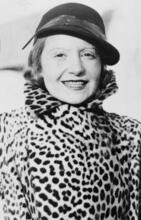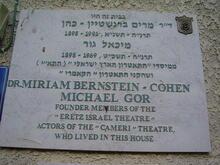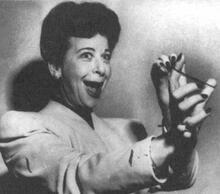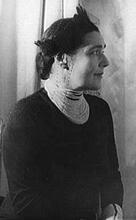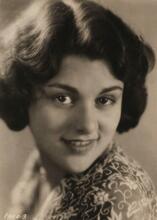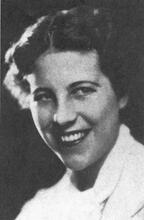Esfir Il’inishna Shub
Esfir Shub was one of the only female creators in the Soviet film industry. In 1922 Shub joined the Soviet film company, Goskino. Her task was to cut and retitle foreign films. In 1926 she started to work on a film to celebrate the tenth anniversary of the revolutionary year of 1917. From what she salvaged, Shub constructed three historical films. These films established Shub’s reputation in the art of the compilation documentary, a form of filmmaking she pioneered in the Soviet Union. In 1929 she collaborated with German communists in Berlin, making films for international use. Shub also developed several propaganda films during World War I. She survived by producing technically competent work that satisfied the political needs of the communist moment.
An early Soviet filmmaker, the friend and colleague of Lev Kuleshov (1899–1970), Sergei Eisenstein (1898–1948), Vsevolod Pudovkin (1893–1953), and others, Esfir Shub was active as an editor, director, and writer of nonfiction films for twenty years, from 1927 to 1947—one of the few women in the Soviet Union at that time to achieve some standing in the film industry.
Early Life and Family
Shub was born on March 16, 1894 (by the new calendar), into a lower middle-class family in Surozh, a small town in the Chernigov region of the Ukraine. Her father, Ilya Roshal, was a pharmacist. Her mother died when Esfir was very young. She had one brother. Shub had a privileged upbringing, coming to Moscow before the revolution to enjoy a life of high culture. While preparing for entry to the prestigious seminar in Russian literature at Moscow’s Institute for Women’s Higher Education, she went to the theater, concerts, and literary events, which brought her into contact with avant-garde writers such as Vladimir Mayakovsky (1893–1930) and Andrei Bely (1880–1934) and exposed her to modern European art. After the Revolution, she spent two years as Vsevolod Meyerhold’s private secretary, working on the Bolshevik program of ideological education through the theater arts.
Early Film Work
In 1922 Shub joined the Soviet film company, Goskino. Her task was to cut and retitle foreign films, putting them into a shape that would be suitable for screening to Soviet audiences, sometimes reducing serials to single features, sometimes sorting out reels that had been mixed up and lacked an obvious clear storyline. Between 1922 and 1925 some two hundred foreign films passed through her hands. She also edited a number of Soviet feature films, among them Wings of a Serf by Yuri Tarich (entitled Ivan the Terrible outside Russia). At the time, employment as film editors was all that women could normally hope for on the production side of the Soviet film industry. (A rare exception was Olga Preobrazhenskaya, who specialized in children’s films before being entrusted with feature work.)
In 1926 Shub was authorized by a rival studio, Sovkino, to start work on a film to celebrate the tenth anniversary of the revolutionary year of 1917, a project that required her to search for and view an enormous quantity of newsreel and other archive footage, including the Tsar’s private collection. At the time, material of this kind was not stored in properly organized archives; much original footage had been lost, destroyed, sold to foreign interests, or allowed to deteriorate beyond repair.
Compilation Documentary Work
From what she salvaged, and by adding new material specially shot for the purpose, Shub constructed three historical films. The first covered events that led to war between the great powers of Europe and the abdication of the Tsar. Entitled The Fall of the Romanov Dynasty, it was released in time for the anniversary of the February revolution. The second, The Great Road, which covered the ten years of Soviet achievement in building communism, from 1917 to 1927, was released for the anniversary of the Bolshevik seizure of power in October. In 1928, the centenary of Tolstoy’s birth, she was ready with The Russia of Nicholas II and Leo Tolstoy, which covered Russia from the birth of motion picture films to the eve of World War I. (Its Russian title can also be translated Leo Tolstoy and the Russia of Nicholas II.)
These three films established Shub’s reputation as a specialist in the art of the compilation documentary. But the studio at first refused to give her due recognition, arguing that she was splicing together existing film and not creating something new. The opening titles of The Fall of the Romanov Dynasty credit her only as “Work by E. I. Shub” (“Work by Esther Shub” in some English-language versions). Mayakovsky voiced his protest at this lack of respect for her achievement as a filmmaker. Though she was credited as director in subsequent films, the episode showed how women were typically held in low esteem in the film industry. Her friendship with Eisenstein was not enough to earn her a screen credit for her work on the script of Strike.
From the earliest years of the motion picture industry, enterprising showmen had made up new films from diverse shots taken from other films, a technique that was famously demonstrated in 1898 when the Lumière operative Francis Doublier fabricated a film for Russian audiences depicting the fate of Alfred Dreyfus in France in 1894. Edwin S. Porter constructed The Life of an American Fireman in 1902/1903 in a similar way. Large numbers of nonfiction films made up of existing topical material appeared during and after World War I. They served commercial, national, and propaganda purposes, among them to bring America into the war and keep Russia from quitting it.
Shub was thus not the first to discover the compilation form, as is often claimed. Her approach to it was ideological and she pioneered its use in the Soviet Union. In Leninist terminology, a film had to be “agitational,” not just historical for its own sake. In selecting and arranging her archive material, such as juxtaposing scenes of the Tsar’s court at play with images of peasants working in the fields, Shub spelled out the party’s class message using frequent title cards. In A Corner in Wheat (1909), a moral fable filmed with actors, D.W. Griffith had produced a similar effect for the Biograph Company. Shub demonstrated how the content of bourgeois film could be made to serve the Soviet cause.
International Film Work
In 1929 Shub went to Berlin to collaborate with German communists in making a film for international use. A combination of material taken from foreign newsreels with new shooting in Berlin and the Soviet Union, the film was released in 1930 with the title Cannons or Tractors in Germany and Today in the Soviet Union. In Berlin Shub experienced sound film for the first time. Her visit—she was one of a group of Soviet film people that included Alexander Dovzhenko—was almost certainly organized by the Comintern’s propaganda genius, Willi Münzenberg.
In the 1930s both democratic and totalitarian governments were at one and the same time wary of, and attracted to, the film medium. In 1933 the British Board of Film Censors extended its rules concerning “objectionable political propaganda” to films consisting of “photographs of current events” and films “made up of a series of topical events ... before and since the War, strung together with a running commentary of a definitely propagandist nature.” The censors’ ban seems precisely aimed against Shub’s kind of historical compilation. But there is no indication that her work was widely known outside the Soviet Union. Cannons or Tractors was promoted in Germany by Münzenberg’s newspapers in articles that extolled the virtuosity of Soviet editing techniques—a possible source for the similar claim later made on Shub’s behalf by western sympathizers of the Stalinist state. In the United States radical filmmakers of the Film and Photo League, supported by the Comintern, applied the same technique of juxtaposing images for editorial effect, as did Louis de Rochement in the March of Time newsreels. (Today received adverse criticism in the Soviet press; Shub recognized she had made mistakes.)
KShE (Komsomol—Chief of Electrification, 1932) was Shub’s first sound film, a celebration of Stalin’s first Five-Year Plan. But it and Shub’s other films have not attracted the same attention from film historians as her historical trilogy. In fact, it is unclear how many of them have been preserved in their original form, if at all. (The Fall of the Romanov Dynasty is the only one in circulation in the west.) In 1935 Shub was awarded the title of Honored Artist of the Republic, placing her with actors and actresses, a lesser honor than the Order of the Red Star bestowed on her contemporary, Dziga Vertov (1896–1954). When the Germans invaded Russia in World War II and Soviet studios were moved to Alma-Ata in Central Asia, Shub and Vertov were among those assigned to produce special-issue newsreels.
Later Career, Anti-Semitism, and Legacy
In her memoirs Shub is noticeably reticent about herself and her struggle as a woman to win respect as a theorist as well as a practitioner in a predominantly male field. She never refers to her Jewish upbringing or to the fate of her family. She was married twice, first to a civil engineer, Isaac Vladimirovich Shub, with whom Esfir had a daughter, Anna, her only child, born soon after the Revolution. The marriage ended in divorce. Her second husband was Alexei Gan, a talented writer and artist and the editor of Kinofot. He disappeared on a trip to the Soviet Far East where he was killed, it was thought, for making jokes about Stalin.
We may surmise that Shub’s survival in part depended on this reticence. Jews in the Tsarist empire suffered pogroms in the countryside and discrimination in Moscow and St. Petersburg if they sought to enter the most prestigious institutions of higher learning in these cities. Shub implies in her memoirs that her application to Moscow’s Institute for Women’s Higher Education was initially denied because she was Jewish and that it was only after a private meeting with her father that the director of the Institute agreed to bend the rules on her behalf.
In the years after World War II Russian anti-Semitism revived. Only Stalin’s death in March 1953 forestalled the unleashing of a new campaign of terror, provoked by the so-called Doctors’ Plot, complete with mass arrests, denunciations, public executions and deportations. The purge was directed against all Jews, but particularly those associated with Soviet culture, who were branded as “rootless cosmopolitans.” Shub and Vertov were among those whose lives were in great danger.
In the Soviet Union filmmaking, of both fiction and nonfiction, was a sensitive task; directors and critics often found it expedient to denounce each other’s work in order to remain employed or even alive. Shub was not one to take artistic risks in her work. She avoided the rhetorical posturing characteristic of Vertov, and she never openly supported colleagues under attack. Like Vertov she was often without immediate projects to work on. A dutiful servant of the Stalinist state, she survived by producing technically competent work that satisfied the political needs of the moment. In her writings she discusses the art of the nonfiction film but she shows no awareness of its development outside the Soviet Union. Her unrealized projects include a script about Soviet women and a travelogue of Turkey. She died in 1959.
Filmography
Padeniye dinasti Romanovikh (The Fall of Romanov Dynasty), 1927.
Veliky put (The Great Road), 1927.
Rossiya Nikolaya II i Lev Tolstoy (The Russia of Nicholas lland Lev Tolstoy), 1928 Segodnya (Today), 1930.
KShE (Komsomol—shef elektrofikatsii), (Komsomol—Chief of Electrification), 1932.
Moskva stroit metro (or Metro Nochyu), (Moscow Builds a Subway, or: Subway at Night), 1934.
Strana Sovetov (Country of the Soviets), 1937.
Ispaniya (Spain), 1939.
20 let sovetskogo kino (20 years of Soviet Cinema), 1940.
Fashizm budet razbit (Fascism will be destroyed), 1941.
Strana rodnaya (Native Country), 1942.
Sud v Smolenske (The Trial in Smolensk), 1946.
Po tu storonu Araksa (On the other side of the River Araks), 1947.
Works
Krupnym planom (In Close Up). Moscow: 1959.
Shub’s memoirs published the year of her death. They consist of a series of studies of her Soviet film colleagues, Eisenstein, Pudovkin and Vertov among them.
Zhizn’ moia—kinematograf (My Life—Cinema). Moscow: 1972.
Shub’s collected works published by the History of Art Institute of the Ministry of Culture. It reprints her memoirs and adds a collection of letters and papers from her estate. The filmography above is based on the one printed in this volume.
On the title page of these two works, the Soviet publishers print her middle name, Il’inichna. In her correspondence in the latter book, however, she consistently spells it Il’inishna.
Attwood, Lynne. Red Women on the Silver Screen: Soviet Women and Cinema from the Beginning to the End of the Communist Era. London: 1993.
Drobashenko, Sergei. “Soviet documentary film, 1917–1940.” In Propaganda, Politics and Film, 1918–1945, edited by Nicholas Pronay and D. W. Spring. London: 1982.
Heller, Mikhail and Aleksandr Nekrich. Utopia in Power: The History of the Soviet Union from 1917 to the Present. New York: 1986.
Konoplyov, Alexander Borisovich. Interview with Natalia Trifonova. Moscow: September 26, 2003.
Leyda, Jay. Films Beget Films. London: 1964.
Idem. Kino: A History of the Russian and Soviet Film. Third edition, London: 1983.
Petric, Vlada. “Esther Shub: Film as a Historical Discourse.” In Show Us Life: Toward a History and Aesthetics of the Committed Documentary, edited by Thomas Waugh. Metuchen, NJ: 1984.
Pronay, Nicholas. “The political censorship of films in Britain between the wars.” In Propaganda, Politics and Film, 1918–1945, edited by Nicholas Pronay and D. W. Spring. London: 1982.
Taylor, Richard and Ian Christie, eds. The Film Factory: Russian and Soviet Cinema in Documents. Cambridge, MA: 1988.
The author gratefully acknowledges the assistance of Natalia Trifonova in the writing of this entry.


